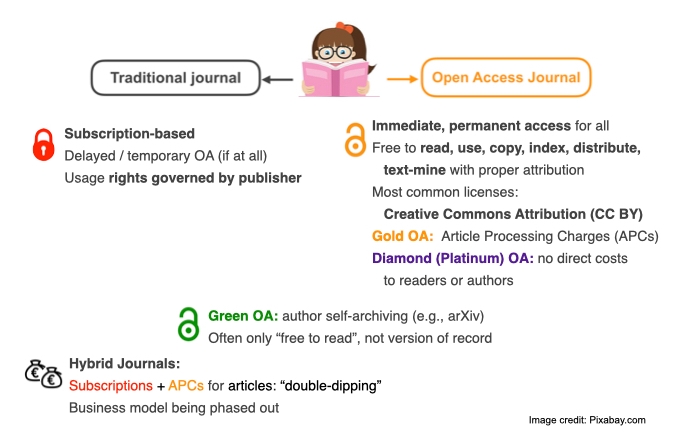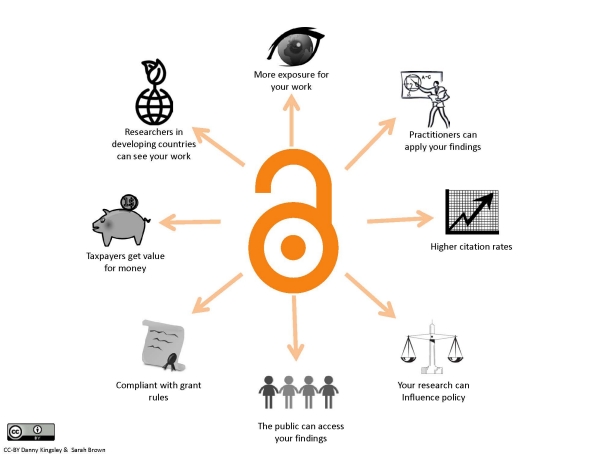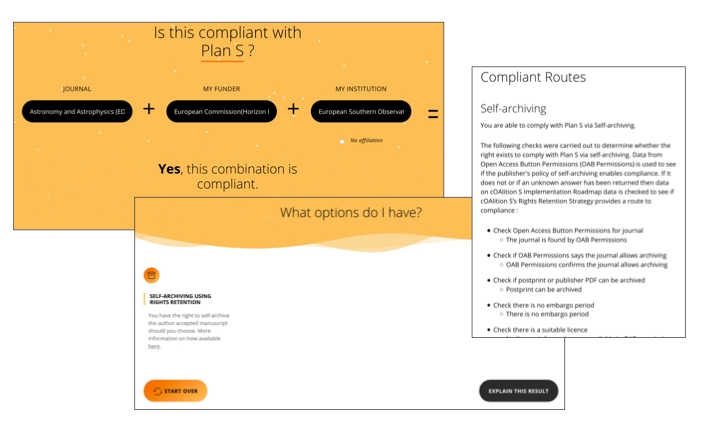Information on Open Access Publishing
The following content is based on the presentation "Open Access in Astronomy - Why Should I Care?" (Feb. 2021). The presentation slides of this and other presentations by the ESO Librarians on various topics can be found on a dedicated webpage.
For EU Commission grant holders, specific information is available on Publication costs and Open Access Requirements.
Background of Open Access Publishing
Definition
Open Access in scholarly literature means the free, immediate, online availability of research articles, coupled with the rights to use these articles, i.e., permitting any users to read, download, copy, distribute, print, search or link to the full text of these articles, crawl them for indexing, pass them as data to software or use them for any other lawful purpose (Scholarly Publishing and Academic Resources Coalition, SPARC).
This definition contains two important aspects: free and immediate availability, and the rights to use the content.
Motivation
The OA movement is nothing new. It started in the 1990s when it gained momentum with the widespread availability of the internet.
The movement always followed two motivations: One is the idea that publicly funded research should be available to everybody in order to advance knowledge exchange. The second motivation was brought forward in particular by libraries who needed to reduce their expenditure for journal subscriptions simply they could not afford anymore the ever rising prices; they also demanded more cost transparency.
Effects
The effects of the early adopter of the Open Access movement were a lot of trying, encouraging, advocating of these ideas by the early adopters among researchers, organisation, funders, and also librarians.
Around that time, Paul Ginsparg at the Los Alamos National Laboratory started the arXiv / astro-ph server, that brought the idea of preprint exchange -- which always has been very well adopted in the Astronomy and High-Energy Physics community -- into the digital era.
Soon, some publishers understood that they needed to re-consider their business model. In a world where everyone shall be allowed to read content “for free”, an easy way out seems to be a model in which now those would be charged who wanted to publish their research, going form a “readers pay” approach (through subscriptions) to an “authors pay” business model built around article publishing fees.
One other problem that surfaced soon were so-called “predatory” journals or even “predatory publishers”. This term refers to those publishers who are willing to publish basically all manuscripts without proper quality control, as long as the authors were willing to pay. In the meanwhile, this problem has been discussed so often that researchers are probably aware of such deceptive journals in which they should not publish; however, the problem is not entirely gone as (too) often shown by “publish with us” invitations that still arrive in the mailboxes of many scientists. The website "Think. Check. Submit." provides a checklist to help researchers assess whether or not a journal is a suitable venue for their papers.
Choices in the Publishing Process
The illustration below explains some terminology, including differences between publishing in a traditional and an Open Access journal.

In case a researcher decides to publish in a traditional journal, access is governed by subscriptions. There may be delayed or temporary open access to specific articles, but that is up to the publisher. Also usage rights — now and in future — are governed by the publisher.
Instead, if she chooses an OA journal, the request for immediate, permanent access for everyone is fulfilled. Not only can her articles be read, but other researchers can also use, index, text-mine them, as long as proper attribution is given. What can or cannot be done by others is typically regulated by licenses, the most commonly used are Creative Commons, such as the Creative Commons Attribution (CC BY) license; other licenses are also possible.
In terms of business models of OA journals, two flavours are most common:
- With Gold OA models, the costs of publication (the so-called Article Processing Charges, or APCs) are calculated on a per-paper level, to be paid either by the authors directly or by their institutions or consortia.
- A second flavour is the so-called Diamond or Platinum Open Access where no direct costs are charged to readers nor authors; instead, the costs are borne by “sponsors”.
In addition to the Gold and Diamond OA models, the Green Open Access model is very widely used in astronomy. Green OA means that authors self-archive their manuscripts. However, it is important to remember that typically Green OA platforms only provide “free to read” access to the articles, and also that the author-deposited manuscripts are not the version of record — that version usually remains with the publisher.
For several years, so-called Hybrid Journals have been around. These are journals that operate on the subscription-based business model, but in addition also offer authors to pay a specific fee for their individual articles to make them available open access. This is considered as charging twice for the same content or “double-dipping”, and has by now obtained a very bad reputation. Also due to funders not supporting this model anymore, it is — or at least should be — phased out.
Benefits of OA Publishing
The advantages of Open Access publishing are not only limited to reliable access and usage rights by your direct peers, but there are further societal benefits. Obviously, OA content can be accessed by researchers around the globe, also from countries which perhaps previously could not afford journal subscriptions. Some studies say that the unobstructed availability of OA research artefacts lead to higher citations; this might be true simply because the research findings are more widely exposed. And very importantly, increasingly funders demand in their grant rules that articles arising from research they financed to be available open access.
Fig. below: Benefits of OA Publishing. Image by Danny Kingsley & Sarah Brown, 2015. CC-BY 4.0.

Plan S (launched by cOAlition S)
Aim
Plan S was announced in 2018 by the Open Access Envoy of the European Commission, Robert-Jan Smits. The S in the name is supposed to stand for solution, shock, or shift…. (or maybe Smits). The aim of Plan S is to make full and immediate Open Access a reality by making it mandatory. Detailed information can be found in the (free) eBook "Plan S for Shock" by Robert-Jan Smits and Rachael Pells.
Strategy
The strategy is to align research funders in the so-called cOAlition S. 15 national funding organisations, among them the European Commission and the European Research Council, got together and developed 10 principles which they apply for the research they fund. Among these principles are for instance the mandate that authors retain copyright of their articles, that they have to publish in quality OA journals, and also that publication in hybrid journals will not be supported. Plan S was supposed to become effective originally in 2020, but there was a lot of discussion and clarification necessary before it could actually really start.
Desired effects
The desired effects of Plan S are a strong shift towards new models in academic publishing, leading to a more transparent, efficient, and fair publishing system.
Real effects (so far, more to come...)
The real effects so far are first and foremost: a vastly increased discussion about OA, possbily even a disruption of the publishing landscape. Plan S clearly shook the boat of academic publishing quite a bit. It has also led to some temporary solutions implemented by publishers in order to be rather fast “Plan S compliant”; these temporary solutions are often called transformative agreements
Plan S Journal Checker Tool
In order to support authors in finding a Plan S compliant way to publish their results, the cOAlition S office provides the Plan S Journal Checker Tool (as of 2022 still in BETA version). "The tool allows an author to enter the name of a funder, an institution and the journal to which they plan to submit an article, and checks if this combination of funder, institution and journal offers any route to compliance with Plan S." (see https://journalcheckertool.org/faq/)

Publication Business Models
In order to provide some order for the often confusing field of business models used in Open Access science publishing, the ESO Library and Information Centre has developed a schematic overview of the mose common models currently used, with a focus on whether or not they are Plan S compliant. The overview includes four model types:
- Gold OA using Article Processing Charges (APCs): involving commercial / society publishers, and Overlay Journals
- Transformative agreements: Read-And-Publish (RAP) and Publish-And-Read (PAR) agreements
- Diamond OA (Library-supported): SCOAP3 and Subscribe to Open (S2O)
- Closed: Subscription and Subscription plus Self-Archiving using Rights Retention
For each business model, the table lists the following properties:
- Status
- Who pays (mostly)?
- How much (answered in a simplified way obviously)
- Who can read (i.e., who has read / use access)?
- Who can publish (i.e., whose publishing costs are covered)?
- Is the model Plan S compliant?
- What is the expected cost evolution?
A full-resolution version of the image is available via DOI 10.18727/docs/15.
Open Access in Astronomy
Core journals
In astronomy, the (only 4 or 5) core journals are governed by Learned Societies (AAS, ESO, RAS) in cooperation with commercial publishers. This is a huge advantage over other subject areas which do not have such a strong involvement of their research community.
Read access
Read access in astronomy is available to over 90% of the current core journal articles, be it through arXiv/astro-ph or because of temporary access provided by the publishers.
Collaborative approach
Historically, astronomy has always had a very collaborative approach, not only with regard to manuscripts and eprints, but there is also a culture of data and code sharing, and other examples.
Why do we need further OA regulations?
- Open Access is here to stay. Some time ago, one may have thought that it will not gain much attention, but the opposite is true. Also, “free to read” is not the same as Open Access.
- This is a good moment to implement the FAIR principles that foresee to make research content Findable, Accessible, Interoperable, and Reusable.
- Funders increasingly demand that research supported by their grants be made available open access, therefore, for those researchers who receive grants from OA-demanding funders publishing Open Access is a Must.
- Open Access is good science practice that is increasingly widely adopted. Astronomy is not (or should not be) outside of these “industry standards”.
How to achieve OA? Some thoughts from key players:
- Publishers need a long-lasting (sustainable) framework with reliable partners.
- Readers would like to be able to access as many articles as possible; this is true in general, but even more so for those researchers whose research is multi-disciplinary.
- Authors would like the transition to OA to be as seamless and non-disruptive as possible.
- Librarians are very aware of how the traditional subscription-based model has led to prices that cannot be afforded anymore. The OA movement, if used well, may be a way towards a more sustainable and collaborative publishing landscape, in particular if OA models are chose hat lead to a more transparent, fair, and open system.
Status of Astronomy Core Journals
AAS (ApJ / Suppl. / Letters, AJ, Open Access since 2022), MNRAS (OA since 2024)
- Full OA as of 2022 (Gold model)
- Costs covered by authors (Article Processing Charges (APCs)); access barrier shifted from reading to publishing
- Requires new infrastructure for those not used to page charges
(budgets/grants needed, publishing priorities tbd if limited OA funds, etc.)
A&A (OA since 2022)
- Slightly modified Subscribe to Open (S2O) model
- Global read-access: assured through continued library subscriptions (conditional OA model: subscription threshold (~95%) must be met, otherwise closed access).
- Publishing: A&A Member States contributions cover publishing costs for MS authors; moderate publishing fees for non-MS authors. Detailed information on page charges is available at https://www.aanda.org/about-aa/masthead/32-author-information/page-charges
- Collaborative model; uses existing infrastructure
- No major changes for majority of authors; high acceptance expected
The Larger View
Impact
With a wide-spread shift to Gold Open Access, costs in scientific publishing are shifting from journal-level to article-level.
Research assessment / evaluation
Looking at open access from a wider angle, the logical next step should be that also research assessment and scientists’ evaluations are shifting to article-level metrics. In particular, research evaluators should stop to mis-use the Journal Impact Factor to judge the output of individual researchers.
Instead, possibly active support of open science activities, such as publishing in, or refereeing for, quality OA journals could become part of researchers’ performance evaluations to make the process more transparent, robust and diverse. Guidelines for such a paradigm shift can be found for instance in the Declaration of Research Assessment (DORA). These are wide-ranging changes for which a paradigm shift in research evaluation is necessary.
Should we rely exclusively on eprints?
Another question that needs to be asked in particular in astronomy, where so many manuscripts are already available free to read, is: Should the community rely exclusively on e-prints? This leads to a number of further questions about the future of peer-review and how quality control can then be guaranteed. Perhaps the publishing or posting volume by now is so high that some kind of pre-selection by editors of science journals are needed?



